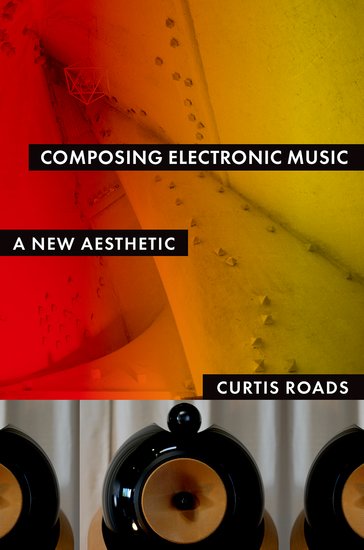Curtis Roads: Composing Electronic Music: A New Aesthetic (2015)
Filed under book | Tags: · composing, composition, electroacoustic music, electronic music, granular synthesis, music, rhythm, sound, technology

“Electronic music evokes new sensations, feelings, and thoughts in both composers and listeners. Opening the door to an unlimited universe of sound, it engages spatialization as an integral aspect of composition and focuses on sound transformation as a core structural strategy. In this new domain, pitch occurs as a flowing and ephemeral substance that can be bent, modulated, or dissolved into noise. Similarly, time occurs not merely as a fixed duration subdivided by ratios, but as a plastic medium that can be generated, modulated, reversed, warped, scrambled, and granulated. Envelope and waveform undulations on all time scales interweave to generate form. The power of algorithmic methods amplify the capabilities of music technology. Taken together, these constitute game-changing possibilities.
This convergence of technical and aesthetic trends prompts the need for a new text focused on the opportunities of a sound oriented, multiscale approach to composition of electronic music. Sound oriented means a practice that takes place in the presence of sound. Multiscale means an approach that takes into account the perceptual and physical reality of multiple, interacting time scales-each of which can be composed. After more than a century of research and development, now is an appropriate moment to step back and reevaluate all that has changed under the ground of artistic practice.
Composing Electronic Music outlines a new theory of composition based on the toolkit of electronic music techniques. The theory consists of a framework of concepts and a vocabulary of terms describing musical materials, their transformation, and their organization. Central to this discourse is the notion of narrative structure in composition-how sounds are born, interact, transform, and die. It presents a guidebook: a tour of facts, history, commentary, opinions, and pointers to interesting ideas and new possibilities to consider and explore.”
Publisher Oxford University Press, 2015
ISBN 9780195373233, 0195373235
xxvii+480 pages
Reviews: Nick Collins (Music and Letters, 2016), Gregory Taylor (Cycling74, 2016), Warren Burt (SoundBytes, 2016).
PDF (24 MB)
Companion website
François Laplantine: The Life of the Senses: Introduction to a Modal Anthropology (2005/2015)
Filed under book | Tags: · anthropology, body, cinema, ethnography, film, image, knowledge, language, life, movement, philology, philosophy, rhythm, sensation, sensory ethnography

“Both a vital theoretical work and a fine illustration of the principles and practice of sensory ethnography, this much anticipated translation is destined to figure as a major catalyst in the expanding field of sensory studies.
Drawing on his own fieldwork in Brazil and Japan and a wide range of philosophical, literary and cinematic sources, the author outlines his vision for a ‘modal anthropology’. François Laplantine challenges the primacy accorded to ‘sign’ and ‘structure’ in conventional social science research, and redirects attention to the tonalities and rhythmic intensities of different ways of living. Arguing that meaning, sensation and sociality cannot be considered separately, he calls for a ‘politics of the sensible’ and a complete reorientation of our habitual ways of understanding reality.”
First published as Le social et le sensible: introduction à une anthropologie modale, Téraèdre, Paris, 2005.
Translated by Jamie Furniss
With an Introduction by David Howes
Publisher Bloomsbury, London, 2015
Sensory Studies series, 1
ISBN 1472534808, 9781472534804
xviii+152 pages
Reviews: Claude Rivière (Recherches sociologiques et anthropologiques, 2006, FR), Fabien Pernet (Anthropologie et sociétés, 2006, FR), Georges Bertin (Esprit critique, 2009, FR).
PDF (updated on 2016-8-20)
More on François Laplantine and sensory ethnography.
Comment (0)André Leroi-Gourhan: Gesture and Speech (1964-65–) [ES, IT, EN]
Filed under book | Tags: · aesthetics, anthropology, art, art history, cognition, language, memory, paleontology, prehistory, rhythm, speech, technics, technology

“André Leroi-Gourhan (1911-1986) was an anthropologist and paleontologist whose theoretical endeavors extended well beyond those realms to encompass the culture of the twentieth century and its most advanced developments. His bold and coherent revision of both analytic and archaeological methods revolutionized the study of prehistoric culture. His adoption of the structuralist method for the analysis of prehistoric art enabled a radical rethinking and clearer understanding of its nature, with resulting implications for the understanding of the art of our own times, and for a broad range of contemporary issues.
Leroi-Gourhan was, for example, concerned with questions of communication, particularly the ways in which new techniques of communication reshape our understanding of language and writing. His work in this field has proved catalytic for the thinking of other major theorists, among them Jacques Derrida. Gesture and Speech combines in one volume Technics and Language and Memory and Rhythms, which are the cornerstones of Leroi-Gourhan’s comprehensive theory of human behavior and cultural development.
In Technics and Language, Leroi-Gourhan looks at prehistoric technology in relation to the development of cognitive and linguistic faculties, expanding on the cultural ramifications of erect posture, a short face, a free hand during locomotion, and possession of movable implements.
Memory and Rhythms approaches its subject from the standpoints of sociology and aesthetics. Here Leroi-Gourhan addresses the problems of instinct and intelligence. He defines the relationship between aesthetic behavior, on the one hand, and species attitudes and the personalization of ethnic groups, on the other, and undertakes a sweeping aesthetic analysis from visceral perception to figurative art, including a discussion of the ‘language of forms’ that makes figurative art an abstract expression of language.”
Originally published in French under the title Le Geste et la parole (t.1: Technique et langage; t.2: La mémoire et les rythmes), Albin Michel, Paris, 1964 and 1965.
Translated by Anna Bostock Berger
Introduction by Randall White
Publisher MIT Press, 1993
October Books series
ISBN 0262121735, 9780262121736
453 pages
Publisher (EN)
El gesto y la palabra (Spanish, trans. Felipe Carrera D., 1971, 20 MB, added on 2015-2-19)
Il gesto e la parola (Italian, trans. Franco Zannino, 1977, 9 MB, added on 2015-2-19)
Gesture and Speech (English, trans. Anna Bostock Berger, 1993, 10 MB)

